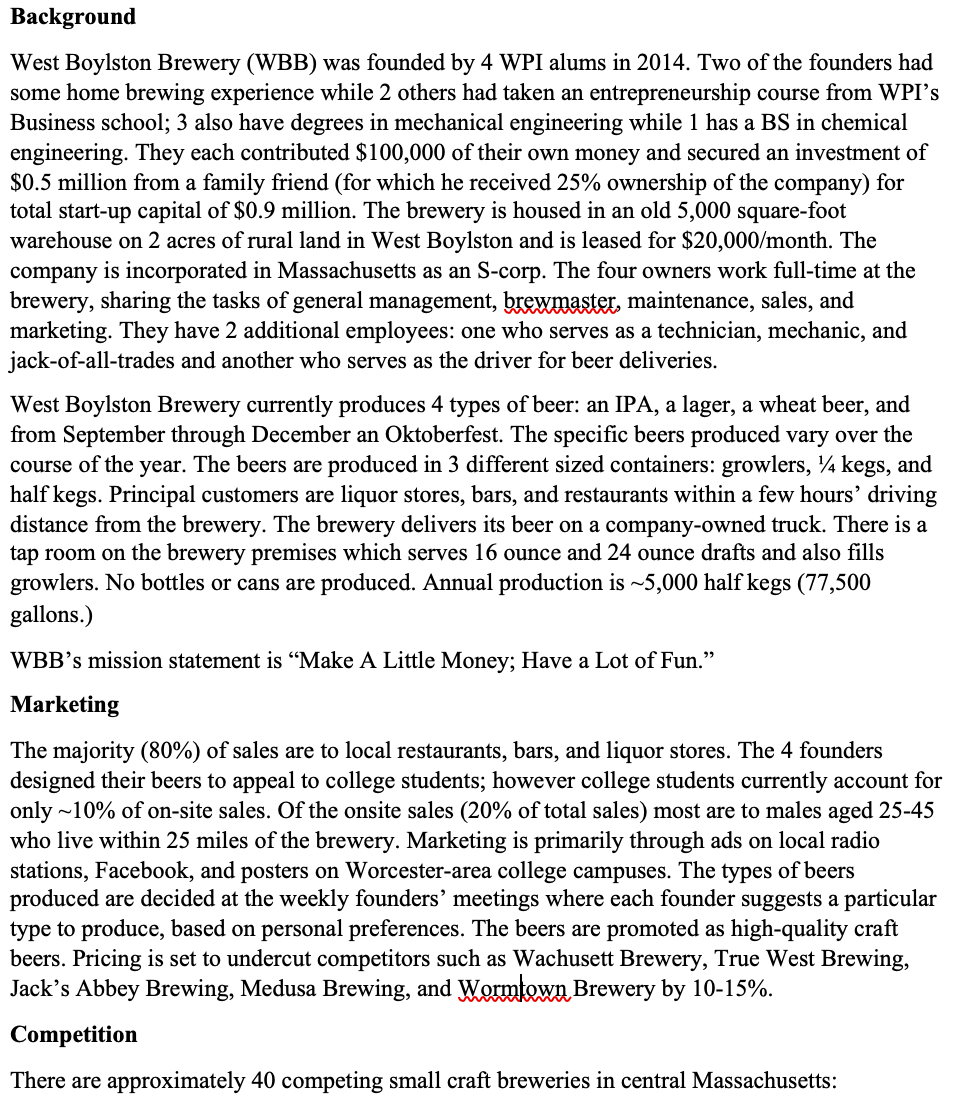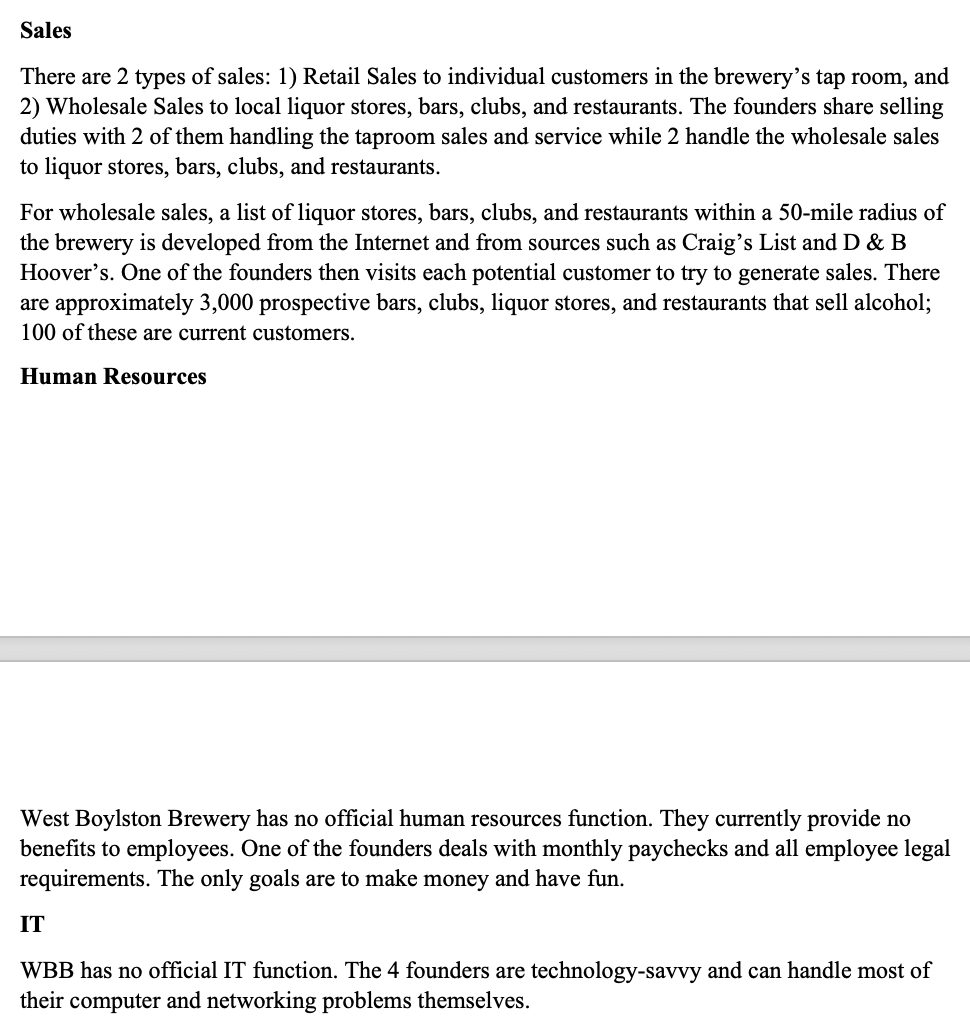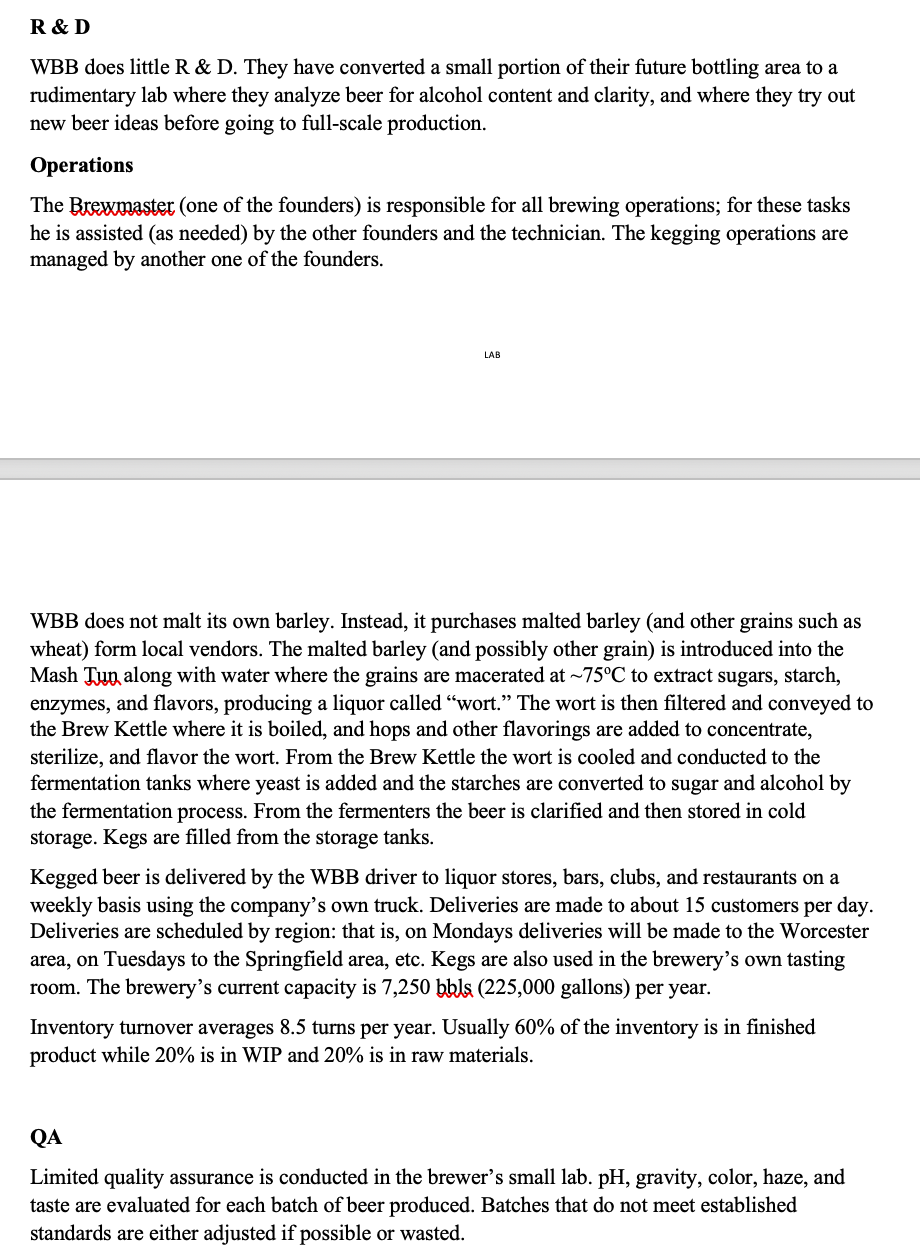Using the case study below and in detail, what is the product description, need of the product, and how does it fit into the market?



Background West Boylston Brewery (WBB) was founded by 4 WPI alums in 2014. Two of the founders had some home brewing experience while 2 others had taken an entrepreneurship course from WPI's Business school; 3 also have degrees in mechanical engineering while 1 has a BS in chemical engineering. They each contributed $100,000 of their own money and secured an investment of $0.5 million from a family friend (for which he received 25% ownership of the company) for total start-up capital of $0.9 million. The brewery is housed in an old 5,000 square-foot warehouse on 2 acres of rural land in West Boylston and is leased for $20,000/ month. The company is incorporated in Massachusetts as an S-corp. The four owners work full-time at the brewery, sharing the tasks of general management, brewmaster, maintenance, sales, and marketing. They have 2 additional employees: one who serves as a technician, mechanic, and jack-of-all-trades and another who serves as the driver for beer deliveries. West Boylston Brewery currently produces 4 types of beer: an IPA, a lager, a wheat beer, and from September through December an Oktoberfest. The specific beers produced vary over the course of the year. The beers are produced in 3 different sized containers: growlers, 1/4kegs, and half kegs. Principal customers are liquor stores, bars, and restaurants within a few hours' driving distance from the brewery. The brewery delivers its beer on a company-owned truck. There is a tap room on the brewery premises which serves 16 ounce and 24 ounce drafts and also fills growlers. No bottles or cans are produced. Annual production is 5,000 half kegs (77,500 gallons.) WBB's mission statement is "Make A Little Money; Have a Lot of Fun." Marketing The majority ( 80% ) of sales are to local restaurants, bars, and liquor stores. The 4 founders designed their beers to appeal to college students; however college students currently account for only 10% of on-site sales. Of the onsite sales ( 20% of total sales) most are to males aged 2545 who live within 25 miles of the brewery. Marketing is primarily through ads on local radio stations, Facebook, and posters on Worcester-area college campuses. The types of beers produced are decided at the weekly founders' meetings where each founder suggests a particular type to produce, based on personal preferences. The beers are promoted as high-quality craft beers. Pricing is set to undercut competitors such as Wachusett Brewery, True West Brewing, Jack's Abbey Brewing, Medusa Brewing, and Wormtown Brewery by 10-15\%. Competition There are approximately 40 competing small craft breweries in central Massachusetts: Sales There are 2 types of sales: 1) Retail Sales to individual customers in the brewery's tap room, and 2) Wholesale Sales to local liquor stores, bars, clubs, and restaurants. The founders share selling duties with 2 of them handling the taproom sales and service while 2 handle the wholesale sales to liquor stores, bars, clubs, and restaurants. For wholesale sales, a list of liquor stores, bars, clubs, and restaurants within a 50-mile radius of the brewery is developed from the Internet and from sources such as Craig's List and D \& B Hoover's. One of the founders then visits each potential customer to try to generate sales. There are approximately 3,000 prospective bars, clubs, liquor stores, and restaurants that sell alcohol; 100 of these are current customers. Human Resources West Boylston Brewery has no official human resources function. They currently provide no benefits to employees. One of the founders deals with monthly paychecks and all employee legal requirements. The only goals are to make money and have fun. IT WBB has no official IT function. The 4 founders are technology-savvy and can handle most of their computer and networking problems themselves. R \& D WBB does little R \& D. They have converted a small portion of their future bottling area to a rudimentary lab where they analyze beer for alcohol content and clarity, and where they try out new beer ideas before going to full-scale production. Operations The Brewmaster (one of the founders) is responsible for all brewing operations; for these tasks he is assisted (as needed) by the other founders and the technician. The kegging operations are managed by another one of the founders. WBB does not malt its own barley. Instead, it purchases malted barley (and other grains such as wheat) form local vendors. The malted barley (and possibly other grain) is introduced into the Mash Tup along with water where the grains are macerated at 75C to extract sugars, starch, enzymes, and flavors, producing a liquor called "wort." The wort is then filtered and conveyed to the Brew Kettle where it is boiled, and hops and other flavorings are added to concentrate, sterilize, and flavor the wort. From the Brew Kettle the wort is cooled and conducted to the fermentation tanks where yeast is added and the starches are converted to sugar and alcohol by the fermentation process. From the fermenters the beer is clarified and then stored in cold storage. Kegs are filled from the storage tanks. Kegged beer is delivered by the WBB driver to liquor stores, bars, clubs, and restaurants on a weekly basis using the company's own truck. Deliveries are made to about 15 customers per day. Deliveries are scheduled by region: that is, on Mondays deliveries will be made to the Worcester area, on Tuesdays to the Springfield area, etc. Kegs are also used in the brewery's own tasting room. The brewery's current capacity is 7,250 bbls ( 225,000 gallons) per year. Inventory turnover averages 8.5 turns per year. Usually 60% of the inventory is in finished product while 20% is in WIP and 20% is in raw materials. QA Limited quality assurance is conducted in the brewer's small lab. pH, gravity, color, haze, and taste are evaluated for each batch of beer produced. Batches that do not meet established standards are either adjusted if possible or wasted









